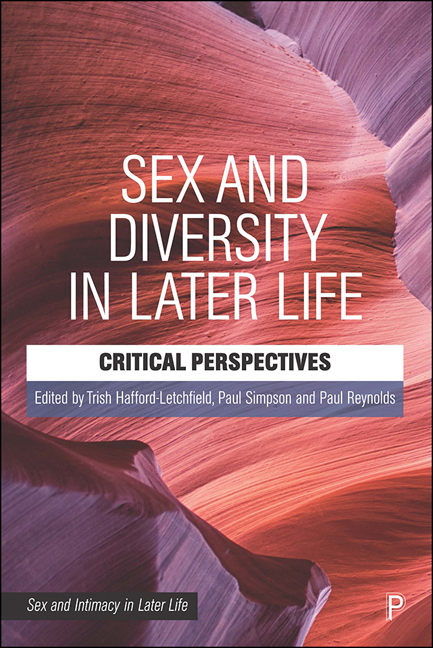Book contents
- Frontmatter
- Dedication
- Contents
- List of figures and tables
- Notes on editors and contributors
- Series editors’ introduction
- Foreword
- 1 Sex and intimacy in later life: a survey of the terrain
- 2 Sexual expression and pleasure among black minority ethnic older women
- 3 Sexual desires and intimacy needs in older persons and towards the end of life
- 4 Heterosexual sex, love and intimacy in later life: what have older women got to say?
- 5 Sex and ageing in older heterosexual men
- 6 Sex and older gay men
- 7 Thinking the unthinkable: older lesbians, sex and violence
- 8 Splitting hairs: Michel Foucault’s ‘heterotopia’ and bisexuality in later life
- 9 The age of rediscovery: what is it like to gender transition when you are 50 plus?
- 10 Ageing asexually: exploring desexualisation and ageing intimacies
- 11 Older people, sex and social class: unusual bedfellows?
- 12 Final reflections: themes on sex and intimacy in later life
- Index
Foreword
Published online by Cambridge University Press: 21 December 2021
- Frontmatter
- Dedication
- Contents
- List of figures and tables
- Notes on editors and contributors
- Series editors’ introduction
- Foreword
- 1 Sex and intimacy in later life: a survey of the terrain
- 2 Sexual expression and pleasure among black minority ethnic older women
- 3 Sexual desires and intimacy needs in older persons and towards the end of life
- 4 Heterosexual sex, love and intimacy in later life: what have older women got to say?
- 5 Sex and ageing in older heterosexual men
- 6 Sex and older gay men
- 7 Thinking the unthinkable: older lesbians, sex and violence
- 8 Splitting hairs: Michel Foucault’s ‘heterotopia’ and bisexuality in later life
- 9 The age of rediscovery: what is it like to gender transition when you are 50 plus?
- 10 Ageing asexually: exploring desexualisation and ageing intimacies
- 11 Older people, sex and social class: unusual bedfellows?
- 12 Final reflections: themes on sex and intimacy in later life
- Index
Summary
Sex and Diversity in Later Life (under the Sex and Intimacy in Later Life book series, edited by Hafford-Letchfield, Simpson and Reynolds), explores how ageing, sex, gender, desire and sexuality shape equality and justice in later life from an intersectional and critical perspective. While sexuality is often perceived as being absent from the lives of older adults, research shows otherwise. The ten substantive chapters address a wide range of topics on a diverse ageing population related to sexual desire, sexual behaviours, love, intimacy, gender, ethnicity, race, sexuality, culture, end of life, chronic health concerns, sexual rights and other pressing social issues. Chapter 1 introduces the theoretical and conceptual perspectives of the book, setting the roadmap for the reader to explore sex and diversity in an ageing population through intersectional, multidisciplinary and critical lenses. Chapter 2 offers a perspective on the sexual rights of African American older women as they pursue love, intimacy and sexual pleasure. Such rights, Harley argues, are impacted by intersecting factors of racism, sexual stigma and cultural barriers. Chapter 3 challenges stereotypes about the ‘oldest old’ and older persons living their final years. Rennie also explores the options of sexual and intimate connections for persons who are at their end of life. In Chapter 4, Hafford-Letchfield reviews some themes on heterosexual desire and sexual expression of solo women in later life within the context of socio-cultural and health-related factors. Chapter 5 discusses sex and ageing of heterosexual men. In the chapter, Tetley and Lee explore heterosexual men's barriers in sexual health and well-being, intersected with perspectives from health professionals on sex and intimacy in later life. In Chapter 6, Robinson explores the narratives from gay men's adventurous stories – sexual encounters with strangers. Their sex and sexuality intersected with the effects of ageism and loss. Robinson argues that the effects of physical ageing or illness can impinge on their making full use of the resources of ageing. In Chapter 7, Todd proposes that, due to hegemonic understandings of gender, sexuality, age and sexual violence, older lesbians with a history of abuse are not sufficiently acknowledged either by professionals or the women themselves. In Chapter 8, Wells reflects on both the sexual intimacies of the ageing bisexual and the limited research on such lived experiences of bisexuality in later life.
- Type
- Chapter
- Information
- Sex and Diversity in Later LifeCritical Perspectives, pp. xxv - xxviPublisher: Bristol University PressPrint publication year: 2021

